This is a guest post by Kendall Stacey, University of Florida graduate and current laboratory research technician in the Dale Lab.
In a time when many people are staying home, gardening and landscaping has become an increasingly popular hobby. If this includes you, it is important that you landscape for biodiversity (or enhancing the abundance and diversity of organisms) while also trying to enhance the appearance and use of your yard or garden. Achieving these goals can make your landscape more attractive, but also promote pollinator activity and enhance natural pest control in your landscape. This post provides tips and resources for landscaping your yard to encourage wildlife, reduce maintenance, and make it more enjoyable for you and your family.
Plant native species
People are often surprised to learn that many of the plants common to residential landscapes are not native to Florida, or even to North America. Think of the crape myrtles, azaleas, camellias, ligustrum, sweet viburnum, and many other southern landscape plant staples that did not originate on this continent.
The use of native and non-native species in residential landscapes has garnered a lot of attention in recent years. This is because several song bird species and native insects have declined in North America and globally, largely due to habitat loss (see, Bringing Nature Home). Mounting research evidence suggests that one of the best ways to attract birds, bees, butterflies, and other beneficial insects into your home landscape is by planting native species. Native plants tend to support more abundant and diverse insects than many non-native plants, thereby providing more food for birds to consume.
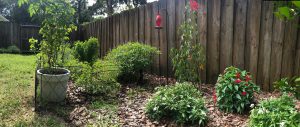
Although native plants provide a lot of value, it is also important to note that many non-native species provide value to residential landscapes as well, culturally, aesthetically, and ecologically. For example, recent research has demonstrated that many non-native plants are equally valuable to insect pollinators and other beneficial insects as natives. A recent UF IFAS guide provides recommendations of native and non-native pollinator plants great for your home landscape.
Native plant considerations for attracting wildlife
In natural habitats, different plants provide different services for wildlife, either by providing food or refuge/habitat. Therefore, it is important to consider specific plant characteristics when creating or enhancing your home landscape. Your overarching goal should be to provide several different plant characteristics so that you can attract and support as many different organisms as possible. If your goal is to attract specific wildlife, then tailoring your garden or landscape plant characteristics to meet those needs is important. Below, we have provided some specific native plant recommendations for enhancing biodiversity in your yard based on plant characteristics.
Floral resources
Many insects and birds rely on flowering plants for pollen or nectar resources. Most flowers are attractive to these organisms, from the size and shape of the flower, to the fragrance emitted, to the color of the petals. However, if you hope to make your yard highly attractive to birds and insect pollinators, there are a few Florida native plants that do this exceptionally well.

Coral Honeysuckle
Looking for a climbing plant to cover a fence or trellis? Coral honeysuckle (Lonicera sempervirens) is a great flowering vine that grows best in North and Central Florida (zones 8-9). The flowers are bright red and the plant blooms from spring through summer. This vining plant does great trellised or on a fence and is often used as a groundcover. The flowers are highly attractive to butterflies and hummingbirds. Other birds, like purple finches and hermit thrushes, enjoy its fruit.
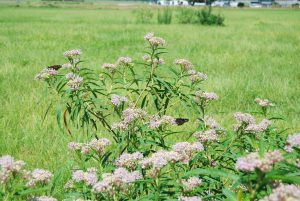
Milkweed
Milkweed (Asclepias spp.) includes several perennial plant species with beautiful clustered flowers – an important nectar source for many pollinators. Milkweed is the host plant for monarch and queen butterfly larvae. When planting milkweed, be sure to choose Florida native species like butterfly weed (Asclepias tuberosa), aquatic milkweed (Asclepias perennis), or swamp milkweed (Aslcepias incarnata). Although tropical milkweed, Asclepias curassavica, is among the most widely available and commonly used milkweed species in Florida, recent research suggests that it may have some negative consequences for monarchs. See, this paper or this paper to learn more about this interesting and complex topic.
Native milkweed flowers also support a wide variety of native bees and wasps, which provide a multitude of beneficial services. There is at least one native milkweed species appropriate for all regions of Florida and most prefer full sun.
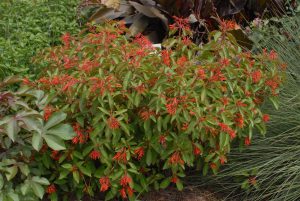
Firebush
Firebush (Hamelia patens) is a perennial shrub that is known to attract butterflies, like the zebra longwing and the gulf fritillary. The fruits are also a favorite of many bird species. This Florida native plant looks great planted as a hedge or border and does well in partial shade. It grows well in zones 8-11 and sports red flowers year-round.

Purple coneflower
Not only does purple coneflower (Echinacea purpurea) have an interesting history of Native American and modern day medicinal use, but it can also be an excellent landscape plant. Purple coneflower, with its picturesque lilac blooms, will thrive in zones 8-10, throughout most of Florida. This perennial plant blooms from spring through summer, grows best in full sun, and is fairly drought tolerant. Purple coneflower is a great nectar source for several butterfly and bee species. In late summer, purple coneflower produces large seedheads which are a favorite snack of goldfinches.

Sunflower
There are a few native species of sunflower (Helianthus spp.) that thrive throughout Florida. These include swamp sunflower (Helianthus angustifolius) and beach sunflower (Helianthus debilis). All species prefer full sun, but swamp sunflower is salt and flood tolerant, while dune and beach sunflower do well in hot, dry locations. Sunflowers are very popular with pollinators, especially honeybees and bumblebees, while the seeds draw in many different species of birds.
Flowers aren’t the whole story
Just because butterflies or bees are flying around your yard, doesn’t mean they are reproducing there. If you are also interested in supporting butterfly reproduction in your yard, include host plants for butterfly species in combination with the flowering plants previously mentioned. Several native butterfly species, including monarchs, swallowtails, fritillaries, and many more rely on specific host plants as caterpillars. Check out this IFAS gardening solutions article on how to plan for and construct a butterfly garden, including a list of butterfly host plants to use in your design. https://gardeningsolutions.ifas.ufl.edu/design/types-of-gardens/butterfly-gardens.html.
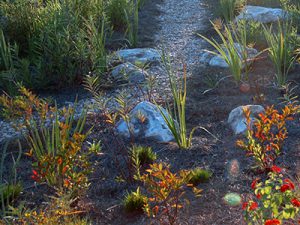
In addition to food, animals need to water to survive. Interestingly, research has shown that water can be regulatory resource in urban areas, which affects bees. So, adding a pond or a bird bath to your yard is a sure way to attract animals and provide ecological value. Landscape design features like, ponds, water gardens, rain gardens, butterfly watering stations, and bird baths can provide creative and attractive options for this. For ideas on providing water to wildlife in your landscape, see: https://gardeningsolutions.ifas.ufl.edu/design/gardening-with-wildlife/providing-water-to-wildlife.html.
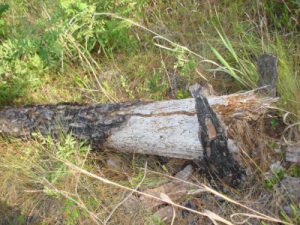
Finally, an often-overlooked method for creating wildlife habitat in your landscape is the addition of rocks, logs, or other structural habitats. Insects and small creatures like snakes, lizards, and toads need hiding places, where they are protected from predators and can stay cool and moist. Additionally, cavity-nesting birds like woodpeckers, the Carolina chickadee, and the brown-headed nuthatch create their nests in decaying wood, which can often be hard to come by in residential areas. If any large branches or trees fall in your yard, consider moving them aside, but keeping them to provide habitat for these beautiful creatures. Similarly, leave behind tree stumps or snags, as they can also provide valuable habitat.
Hopefully this information can get you started on your way to promoting biodiversity around your home. We encourage you to use the wide array of resources available through UF/IFAS Extension. For more specific information on attracting wildlife to your home garden or landscape, visit the UF/IFAS Gardening Solutions webpage or the UF IFAS Florida Friendly Landscaping Guide.
 0
0
